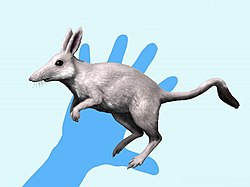History
Although not named until 1927, Florentino Ameghino described a species now seen as synonymous with Lycopsis torresi, Anatherium oxyrhynchus, in 1895 based on a mandibular ramus with several teeth. [2] [3] The fossil was recovered from Puesto Estancia La Costa in Santa Cruz, Argentina, dating to the Miocene. [3] The type material of Lycopsis was collected in July 1895 by "C. Berry" from the middle Miocene strata of the Santa Cruz Formation along the Santa Cruz River in the same area. [2] [4] The fossils (MLP 11–113) were fragmentary, constituting only several fragmentary jaw sections from the maxilla and mandible, including several molars. [4] [5] However, these fossils were not named until in 1927, Ángel Cabrera named Lycopsis torresi, the generic name meaning "wolf-like aspect" after the anatomy of the mandible and the specific name after Argentine paleontologist and the director of the Museo de la Plata at the time, Luis Maria Torres. [4]
This page is based on this
Wikipedia article Text is available under the
CC BY-SA 4.0 license; additional terms may apply.
Images, videos and audio are available under their respective licenses.









